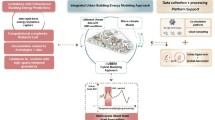Abstract
This paper explores the ground-breaking approach that quantum computing may have in spatial and resource sciences, capitalizing on the advanced capabilities to revolutionize applications of quantum machine learning (QML). It explores the integration of quantum algorithms with traditional spatial econometric models, highlighting their potential impact on critical areas such as environmental and resource economics, urban planning, and regional development. The paper establishes a robust theoretical foundation for spatial quantum-enhanced machine learning, demonstrating how it can significantly refine the accuracy and efficiency of spatial-temporal data analysis. This enhancement is critical for effectively understanding and addressing challenges in environmental change, urbanization trends, and resource allocation. The innovation of spatial QML models may soon support managing complex, high-dimensional spatial datasets, which often pose significant challenges for classical computing methods. The paper illustrates the capacity of quantum computing to deliver more precise predictions and deeper insights into spatial dynamics, thereby acting as a transformative tool for policymakers and planners in city and regional planning. The findings highlight the practical applications of QML in spatial and resource sciences and pave the way for new research directions. This work is a seminal contribution to the emerging spatial quantum machine learning field, offering a new perspective and cost-efficient methodology for tackling complex spatial issues.


Similar content being viewed by others
References
Al-Alimi, D., Al-qaness, M.A., Cai, Z.: Speeding Up and Enhancing the Hyperspectral Images Classification. In International Conference on Artificial Intelligence Science and Applications (pp. 53–62). Cham: Springer Nature Switzerland. (2022), August
Anselin, L.: Spatial effects in econometric practice in environmental and resource economics. Am. J. Agric. Econ. 83(3), 705–710 (2001)
Baiardi, A., Christandl, M., Reiher, M.: Quantum computing for molecular biology. ChemBioChem. 24(13), e202300120 (2023)
Biamonte, J., Wittek, P., Pancotti, N., Rebentrost, P., Wiebe, N., Lloyd, S.: Quantum machine learning. Nature. 549(7671), 195–202 (2017)
Dowling, J.P., Milburn, G.J.: Quantum technology: The second quantum revolution. Philosophical Trans. Royal Soc. Lond. Ser. A: Math. Phys. Eng. Sci. 361(1809), 1655–1674 (2003)
Fischer, M.M., Getis, A.: Advances in spatial analysis. In: Recent Developments in Spatial Analysis: Spatial Statistics, Behavioural Modelling, and Computational Intelligence, pp. 1–12. Springer Berlin Heidelberg, Berlin, Heidelberg (1997)
Herman, D., Googin, C., Liu, X., Sun, Y., Galda, A., Safro, I., Alexeev, Y.: Quantum computing for finance. Nat. Reviews Phys. 5(8), 450–465 (2023)
Jadhav, A., Rasool, A., Gyanchandani, M.: Quantum Machine Learning: Scope for real-world problems. Procedia Comput. Sci. 218, 2612–2625 (2023)
Kerenidis, I., Landman, J., Luongo, A., Prakash, A.: q-means: A quantum algorithm for unsupervised machine learning. Adv. Neural. Inf. Process. Syst., 32. (2019)
Khan, T.M., Robles-Kelly, A.: Machine learning: Quantum vs classical. IEEE Access. 8, 219275–219294 (2020)
Liu, Y., Arunachalam, S., Temme, K.: A rigorous and robust quantum speed-up in supervised machine learning. Nat. Phys. 17(9), 1013–1017 (2021)
Lloyd, S., Mohseni, M., Rebentrost, P.: Quantum algorithms for supervised and unsupervised machine learning. arXiv preprint arXiv:1307.0411. (2013)
Mahata, K., Sarkar, A., Das, R., Das, S.: Fuzzy evaluated quantum cellular automata approach for watershed image analysis. In: Quantum Inspired Computational Intelligence, pp. 259–284. Morgan Kaufmann (2017)
Sahimi, M., Tahmasebi, P.: The potential of Quantum Computing for Geoscience. Transp. Porous Media. 145(2), 367–387 (2022)
Sood, S.K., Agrewal, M.: Quantum Machine Learning for Computational Methods in Engineering: A systematic review. Arch. Comput. Methods Eng., 1–23. (2023)
Sood, V., Chauhan, R.P.: Archives of quantum computing: Research progress and challenges. Arch. Comput. Methods Eng., 1–19. (2023)
Tang, W., Wang, S.: Navigating High Performance Computing for Geospatial Applications, pp. 1–5. High Performance Computing for Geospatial Applications (2020)
Ur Rasool, R., Ahmad, H.F., Rafique, W., Qayyum, A., Qadir, J., Anwar, Z.: Quantum computing for healthcare: A review. Future Internet. 15(3), 94 (2023)
van Erp, T., Gładysz, B.: Quantum Technologies in Manufacturing Systems: Perspectives for application and sustainable development. Procedia CIRP. 107, 1120–1125 (2022)
Vaz, E.: The future of landscapes and habitats: The regional science contribution to the understanding of geographical space. Habitat Int. 51, 70–78 (2016)
Vaz, E.: Regional Science. In A. Kobayashi (Ed.), International Encyclopedia of Human Geography (Second Edition) (pp. 357–361). Elsevier. (2020)
Verleysen, M., François, D.: The curse of dimensionality in data mining and time series prediction. In International work-conference on artificial neural networks (pp. 758–770). Berlin, Heidelberg: Springer Berlin Heidelberg. (2005), June
Author information
Authors and Affiliations
Corresponding author
Additional information
Publisher’s Note
Springer Nature remains neutral with regard to jurisdictional claims in published maps and institutional affiliations.
Electronic supplementary material
Below is the link to the electronic supplementary material.
Rights and permissions
Springer Nature or its licensor (e.g. a society or other partner) holds exclusive rights to this article under a publishing agreement with the author(s) or other rightsholder(s); author self-archiving of the accepted manuscript version of this article is solely governed by the terms of such publishing agreement and applicable law.
About this article
Cite this article
Vaz, E. Quantum machine learning in spatial analysis: a paradigm shift in resource allocation and environmental modeling. Lett Spat Resour Sci 17, 11 (2024). https://doi.org/10.1007/s12076-024-00374-y
Received:
Accepted:
Published:
DOI: https://doi.org/10.1007/s12076-024-00374-y




